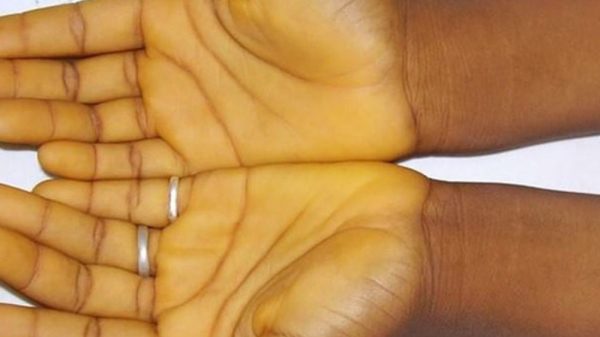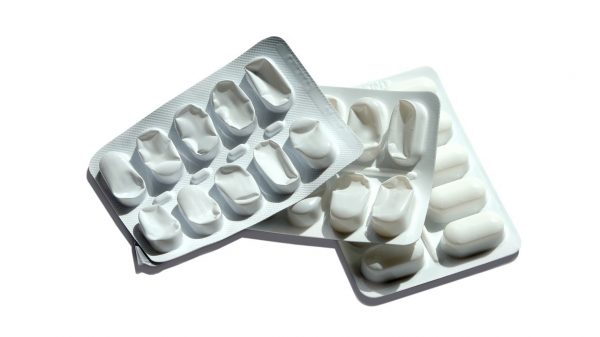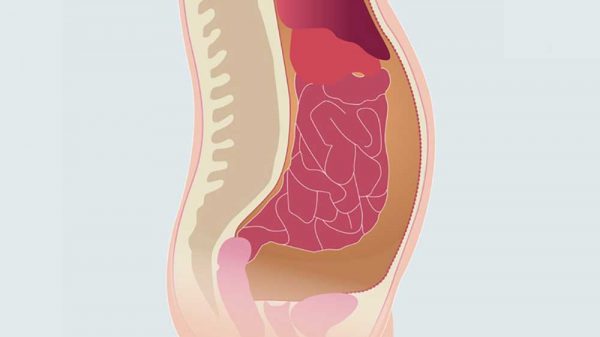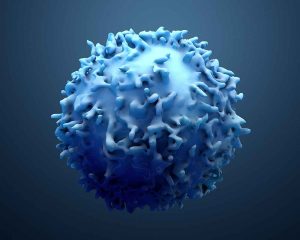Hemochromatosis is a surprisingly common genetic disorder that impacts the way that your body handles iron. If you’ve recently found out that you have hemochromatosis, you may be wondering how to lower iron levels. By altering the food you eat and following a hemochromatosis diet plan, you can reduce the likelihood of complications down the road.
First, let’s take a look at what hemochromatosis is and how the condition affects your body.
Understanding Hemochromatosis
If you have primary hemochromatosis, also known as hereditary hemochromatosis, then your body is prone to absorbing and holding onto excess iron.
Having some iron in the body is important for maintaining optimal health. Iron is a crucial element in facilitating many biological reactions throughout the body. One particularly important example is the role of iron in hemoglobin and myoglobin. Hemoglobin is the protein responsible for supplying all of our cells with oxygen, while myoglobin allows oxygen storage in muscle cells. (1)
Iron is necessary for the healthy functioning of all of our cells and organs. Having too much iron, on the other hand, can be detrimental. Hemochromatosis is a genetic disorder that changes the way the cells in your body handle iron. This leads to iron deposits throughout your body, especially in your liver, heart, and joints.
The condition is characterized as an autosomal recessive inherited disorder, meaning that in order to show signs of hemochromatosis, your DNA must have two copies of the recessive gene. Research has identified a mutation in the HFE gene as a primary cause of hemochromatosis.
If you have one copy of the unmutated (or dominant) gene, and one copy of the mutated (or recessive) gene, you are a carrier of hemochromatosis without actually expressing any characteristics of the condition. This genetic configuration means you are heterozygous for the HFE gene, meaning you have two different forms of the gene: one unmutated gene, and one mutated copy.
If you have two copies of the mutated HFE gene, your body will produce abnormal proteins that are responsible for handling iron. (2)
This genetic configuration means you are homozygous for the HFE gene, meaning both copies of the gene are the same.
In particular, individuals with hemochromatosis will produce abnormally low amounts of hepcidin – a hormone that balances the absorption of iron in the digestive system. Without sufficient levels of hepcidin, more iron is absorbed through the intestine and enters the bloodstream, ultimately being deposited in other organs. (3)
Symptoms of Hemochromatosis
You may have been diagnosed with hemochromatosis without any symptoms. High levels of ferritin- a protein responsible for storing and transporting iron throughout the body – will alert physicians to the presence of hemochromatosis. Increased levels of ferritin indicate that the iron level in your body is high. Transferrin saturation is another diagnostic tool used in hemochromatosis. Transferrin is another protein in the blood that carries iron throughout the body. If transferrin saturation is high, this means transferrin is binding high levels of iron, indicating that you have excess iron in your body.
If you have hemochromatosis, possible symptoms include:
- Fatigue
- Low energy
- Joint pain
- Heart palpitations
Long-Term Complications
If you have hemochromatosis, iron tends to build up in your body. Without treatment, iron accumulation can have serious repercussions, including: (2)
- Liver cirrhosis
- Heart failure
- Arthritis
Hemochromatosis and Fatty Liver Disease
Hemochromatosis is not characterized as an inflammatory condition and therefore does not increase your chances of developing fatty liver disease. However, research suggests that if you have increased ferritin levels combined with nonalcoholic fatty liver disease, you are at a higher risk of developing more severe liver fibrosis. (4)
Fibrosis describes the development of hardened scar tissue that impedes normal functioning. This, in turn, can increase the chances of liver cirrhosis and liver failure.
In order to prevent negative health consequences, it is critical to take steps to treat hemochromatosis and reverse fatty liver disease.
Treatment of Hemochromatosis
The goal is to identify hemochromatosis before iron accumulation causes organ damage. Iron levels in the blood may also be controlled by regularly donating blood, either at a blood bank or a medical clinic. Your physician may suggest erythrocytapheresis, which removes only red blood cells from the body, leaving the remaining blood components. Additionally, certain medications are designed to cause iron chelation, meaning that the medication reacts with iron and removes it from the body. There are numerous ways to prevent iron from accumulating and causing complications – always follow your doctor’s advice regarding the treatment of your condition.
Additionally, hemochromatosis is manageable with certain dietary changes.
Diet for Hemochromatosis: Foods to Eat and Foods to Avoid
If you’re wondering how to lower ferritin levels or iron levels associated with hemochromatosis, dietary adjustments can help. The main pillars of the hemochromatosis diet are: avoiding dietary iron, eating foods that inhibit iron absorption, and avoiding iron supplements.
1. Avoid Some (But Not All) Dietary Sources of Iron
There are two types of iron that you can get through the foods you eat: heme iron and nonheme iron. Heme iron is found mainly in animal products; nonheme iron is found primarily in plant products. Heme iron is more readily absorbed than nonheme iron after consumption. (5)
In contrast, the majority of nonheme iron passes through the digestive tract without being absorbed into the bloodstream. If you have high iron levels, foods to avoid include most meat products, since they are high in heme iron and may increase the amount of iron absorbed in digestion.
To limit the amount of heme iron in your diet, limit or avoid meat products, including:
- Red meat, like ground beef and steak
- Chicken
- Turkey
- Ham
- Tuna
- Sardines
- Shrimp
- Scallops
2. Eat Foods That Block Iron Absorption
Tannins
Some research shows that tannins found in foods may help inhibit the absorption of dietary iron. Tannins are organic compounds found in many plant products, like tea and wine.
Research shows that tannins may play a role in decreasing the absorption and bioavailability of iron. This, in turn, would be beneficial for those with hemochromatosis, by limiting the accumulation of iron in the bloodstream and organs. There are two types of tannins – those found in tea and condensed tannins. The tannins found in tea seem to more effectively block iron absorption. Tannins also exhibit antioxidant effects, so consuming a variety of teas and food sources of condensed tannins may also help your body decrease inflammation. (6)
Phytate
Phytate is another natural compound that plays a role in reducing the amount of iron in the body. Researchers at the Swiss Federal Institute of Technology in Zurich, Switzerland, studied the impact of beans on iron bioavailability in women. The beans administered included those naturally high phytic acid, as well as those that have been genetically altered to have lower phytic acid. Results revealed that consuming beans with low amounts of phytic acid led to a significant increase in iron bioavailability. (7)
To help limit the amount of iron that your body absorbs, try incorporating high-phytate foods into your diet. Most plant-based foods are rich sources of phytate.
Foods that contain phytates include:
- Black beans
- Chickpeas
- Lima Beans
- Pumpkin seeds
- Walnuts
- Peanuts
- Cashews
- Quinoa
- Rice
- Oats
- Buckwheat
- Lentils
3. Avoid Food That Increases Iron Absorption
You can limit iron accumulation by avoiding foods that facilitate the uptake of iron in your body. Vitamin C is effective in converting nonheme iron into a useable form. To help limit iron absorption, avoid eating high quantities of vitamin C rich foods when you’re also consuming foods high in iron. (8)
Foods high in vitamin C include:
- Red and yellow peppers
- Citrus fruits like oranges and grapefruit
- Kiwi
- Cauliflower
- Kale
Vitamin C is also a potent antioxidant that supports immune function and healing. You should not eliminate vitamin C from your diet; instead, just shift the timing of consumption so that you’re not combining vitamin C and iron at the same time.
4. Avoid Food That Has Been Fortified with Iron
Because iron is an essential nutrient, some foods have been iron-fortified to increase their nutritional value. These fortified foods are often processed and refined grains – like cereal, pasta, and bread – that normally lack nutrients like iron. Adding iron to food is helpful for preventing anemia, which can be caused by iron deficiency. Additionally, if you are taking supplements like multivitamins, make sure they do not contain iron.
Protein, Iron, and a Plant-Based Diet: Your Questions Answered
If you’re limiting the amount of meat in your diet to reduce iron intake, you are also limiting a source of optimal amino acids. Amino acids are the compounds that comprise protein and there are nine essential acids that we must get through the foods we eat. We must obtain optimal ratios of these amino acids in order to most effectively support our biological functions, including cellular repair, muscle synthesis, and the production of neurotransmitters.
With limited meat intake, it may be more difficult to obtain all essential amino acids in ideal quantities. Small amounts of low-fat dairy products will help supply essential amino acids. These amino acids are also present in whole plant-based foods, like whole grains, vegetables, fruits, nuts, seeds, beans, and soy. With the exception of soy, plant-based foods tend to be incomplete when it comes to their amino acid profiles. However, consuming a variety of plant-based products will ensure that you get all the protein and amino acids you need to be healthy.
If you are on a strictly vegan diet, supplementing with essential amino acids can help you make sure you’re getting enough amino acids without worrying about combining the right foods. Some essential amino acids may also be beneficial for inhibiting iron storage. A study published in Liver International and conducted on rat models demonstrates the impact that essential branched-chain amino acids (BCAA) may have in preventing iron storage in the liver. (9) The benefits of BCAA on the liver are well-established, with BCAA showing promise in supporting liver health, inhibiting liver cancer growth, and even improving symptoms of hepatic encephalopathy. If you’re considering adding supplements to your diet, always talk to your doctor to make sure your supplements and diet plan work with your medications to best support your health.
Things to Keep in Mind: Types of Hemochromatosis
As mentioned above, primary hemochromatosis develops as a result of a genetic abnormality.
On the other hand, secondary hemochromatosis – also known as iron overload – is a side effect of another health condition. Certain health circumstances that may lead to secondary hemochromatosis include diseases that require you to have blood transfusions, liver diseases like hepatitis, heavy alcohol consumption, and even excessive and unnecessary iron supplementation. (10) If you have secondary hemochromatosis, talk to your doctor about how to best treat the underlying cause of hepatic iron accumulation.
Conclusion
Though it doesn’t always cause symptoms, severe hemochromatosis can lead to liver and organ damage is left untreated. However, hemochromatosis can be managed with medical interventions and dietary changes to prevent iron accumulation.
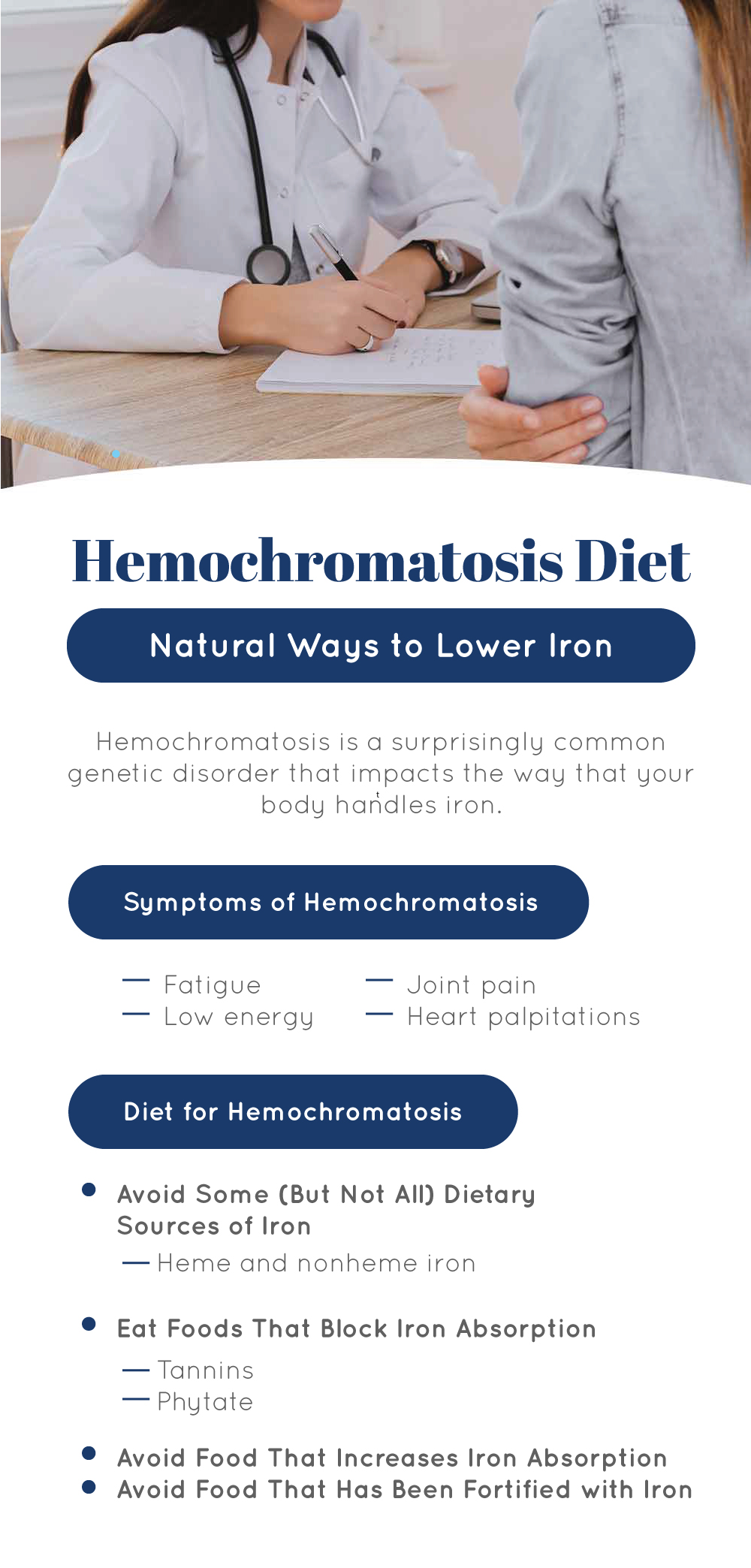
References:
(1) https://www.ncbi.nlm.nih.gov/pmc/articles/PMC3257743/
(2) https://www.ncbi.nlm.nih.gov/pmc/articles/PMC6464659/
(3) https://www.ncbi.nlm.nih.gov/pmc/articles/PMC2855274/
(4) https://www.ncbi.nlm.nih.gov/pmc/articles/PMC3245347/
(5) https://academic.oup.com/ajcn/article/91/5/1461S/4597424
(6) https://www.ncbi.nlm.nih.gov/pmc/articles/PMC5998341/
(7) https://www.ncbi.nlm.nih.gov/pubmed/23784069
(8) https://www.ncbi.nlm.nih.gov/pubmed/2507689
(9) https://www.ncbi.nlm.nih.gov/pmc/articles/PMC4409847/
(10) https://www.niddk.nih.gov/health-information/liver-disease/hemochromatosis
